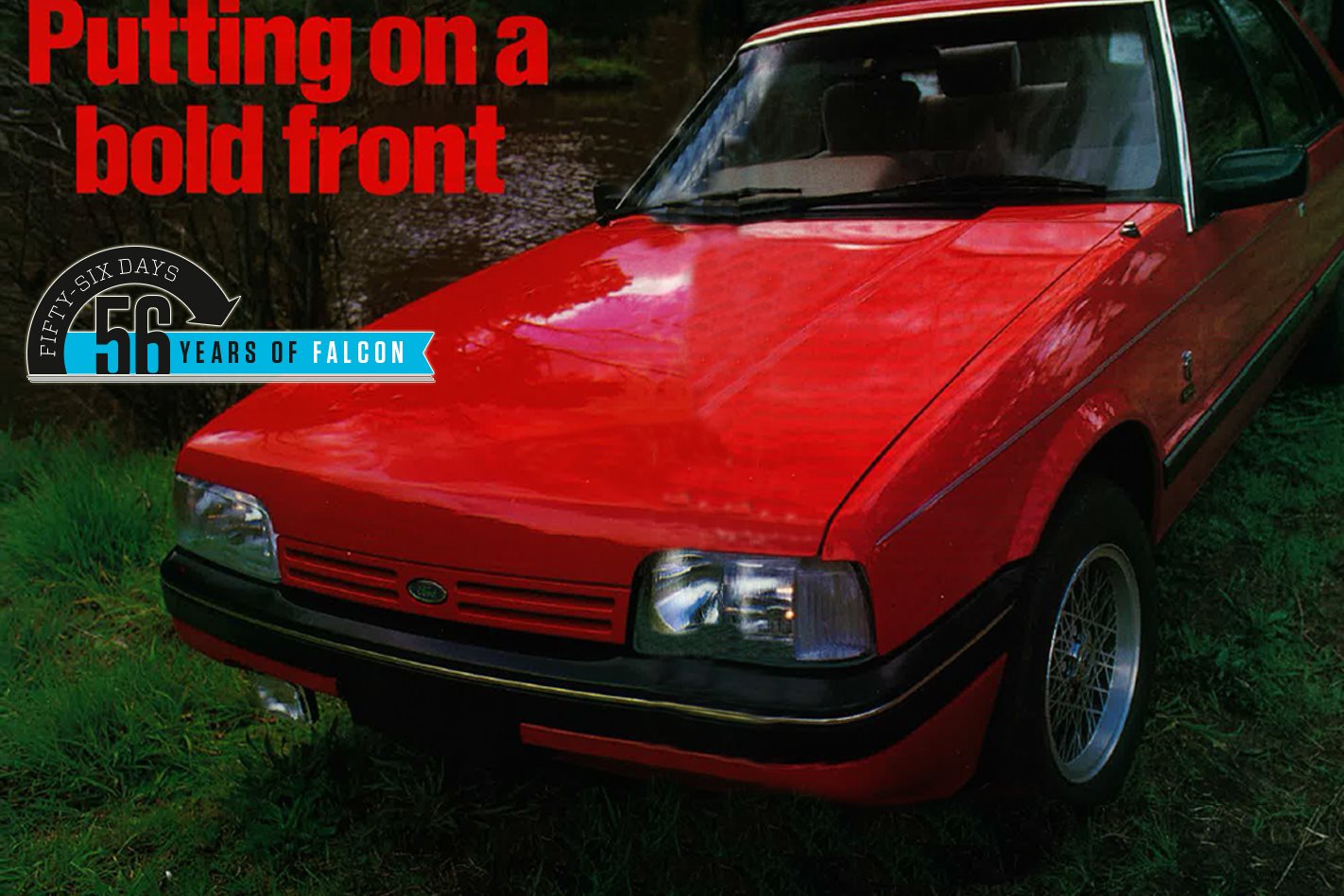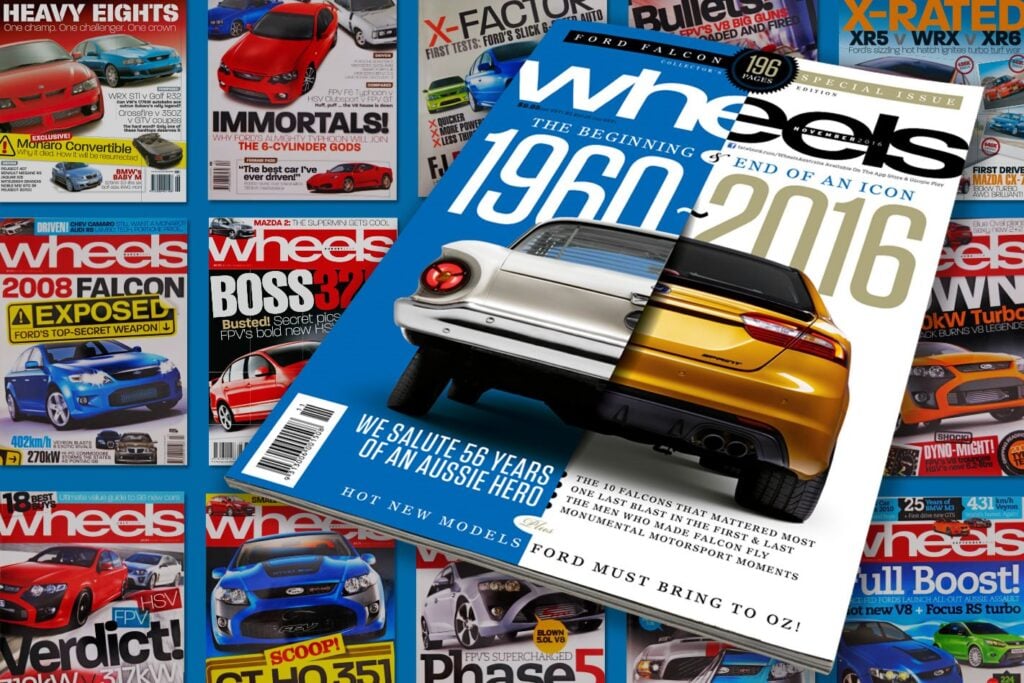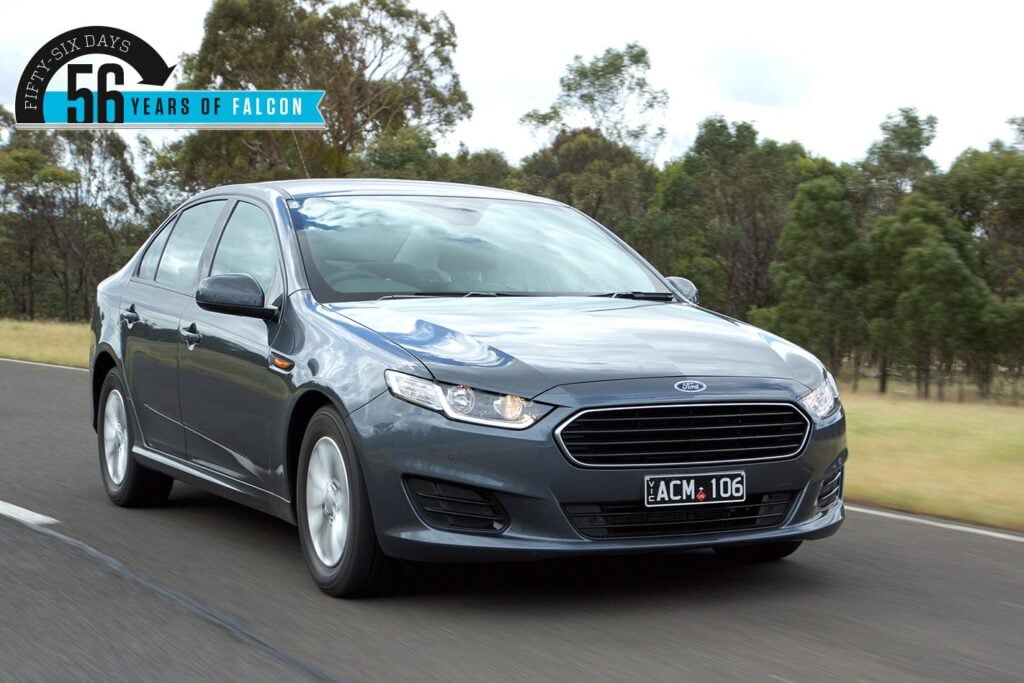First published in the November 1984 issue of Wheels magazine, Australia’s best car mag since 1953.
Ford shifts the Falcon into the era of electronic engine management.
The XF Falcon is a lot more than just a facelift; it has more performance, better economy, improved ride, new instrument panels, and much, much more. Mike McCarthy reports.
FORD IS proof that one doesn’t have to be Number Two to try harder. Far from relaxing in the top spot, Ford is dedicated to staying there. You can see that in the XF Falcon, for it goes far beyond what’s needed just to appear new and different.
Ford has tried very hard to make this a genuinely better car and demonstrably the best Falcon yet; no small aim for the third edition of what is the fourth Falcon series, and the 14th model since the XK of 1960.
The face-lifted styling serves mainly to identify the new version, clearly distinguishing it from the XE and XD before it. But for the XF (as the Falcon, Fairmont and Fairmont Ghia are coded, with ZL Fairlane and FE LTD), the changes go much deeper.
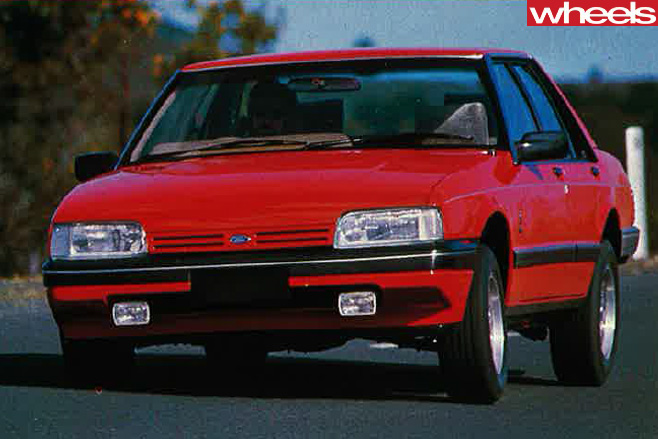
Besides taking the XF specifications and equipment levels further than many (including WHEELS) expected, Ford pulled out all stops to get the XF program through the works from boardroom to showroom in just 36 months instead of the usual 48, with design and engineering tightened to about two-thirds the usual time for an upgrade of this magnitude. Ironically, the $40 million project could have been undertaken a bit later and/or slower because, according to a Ford person: “had we known how well the XE was going to sell we could have kept it longer and targeted the XF for early ’85.”
As with the XE, the XF Falcon range consists of GL, Fairmont and Fairmont Ghia models, in ascending order, with the longwheelbase Fairlane and LTD at the top of the tree. The ESP Falcon as such has been dropped but the sporty S Pack option continues.
Also still very much a part of the line-up is the Falcon wagon of course, and the only surviving traditional Australian ute and van.
The cosmetic changes are the most obvious distinguishing features of the new models, particularly among the Falcon family. Here everything forward of the doors is peculiar to the XF. At the front, the bonnet and guards have softer lines to blend smoothly with the high-tech headlamps.
Behind the single wrap around lenses are the turn indicators, main lights and supplementary driving lights (on all models). Between the lamps is a small, slotted, argent (grey) coloured grill for the GL and Fairmont. It’s painted body colour on the Ghia. Below is an energy absorbing bumper with integrated body-colour valance and air dam beneath the black rubbing face.
The front bumper and panel treatment is repeated at the rear where the styled tail lamps fit the original positions. Also new, and typical of the attention to detail throughout the XF, is the revised rego plate/fuel filler cover with an inbuilt cupped section which holds the fuel cap so the cap keeps the spring-loaded lid open during refuelling.
Although the front-end’s softened lines tend to make the Falcon look a little smaller and narrower than before, the width is unchanged and the length is increased by 59 mm; there’s 56 mm more front overhang and three mm more rear. One suspects the new front-end may have slightly better aerodynamic penetration than the old, but Ford disclaims any tangible benefit in drag reduction. Admitting that the Falcon’s drag factor isn’t exactly state of the art, Ford says the XF body hasn’t been tested in a full size wind tunnel (see WHEELS Oct).
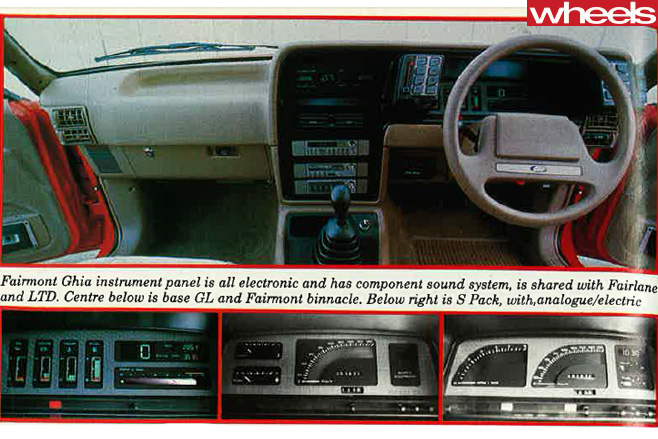
The modernised interiors can claim a very large proportion of the XF’s features, from something as small as the driver’s (adjustable) foot rest to others as obvious as three different sets of instruments. Ergonomics played a large part – as it should – in the interior design. Gone is the XD/XE’s slightly askew driving position, for instance. Even in the standard GL the relationship between the pedals, wheel and seat assures improved comfort. In the Fairmont and higher line models cushion tilt and steering wheel height adjustments are included.
If the GL/Fairmont four-spoke wheel seems familiar that’s because it is a carryover from the XE. The difference is that the any-colour-so-long-as-it’s-black policy has gone. Interiors are now colour-keyed, including wheel and facia.
The Ghia, Fairlane and LTD get a distinctive two-spoke wheel with soft rim. Besides different trim materials (from vinyl in the ute and van, to twill in the GL, cloth in the Fairmont, Ghia and Fairlane, a and velour for the LTD), the obvious change to the front bucket seats is the upholstered headrest replacing the moulded inverted U type. The new headrest has fore/aft adjustment in all models above the GL. Although the bucket seat base and frame are unchanged, reshaped cushion and backrest pads improve support and comfort. The three-seater ‘centafold’ front bench is standard in the base ute and van, optional for GL models.
All the sedans’ rear seats include a fold-down centre section giving a large access port between cabin and boot, and enabling easy stowage of long luggage such as skis.
The top of the lowered centre section has a hard face which serves as a tray or table. In models above the GL the centre section’s front face includes a fold-out armrest. The Ghia and higher models have adjustable rear headrests.
The new instrument panels are almost a story in themselves for number and variety of features. Base model GLs and Fairmonts share a compact instrument binnacle directly ahead of the wheel, with heat/vent controls on a central facia, locking glovebox to the left and a flat upper face. The binnacle carries two fingertip switches either side: parking/headlamps and hazard on the right, panel/dome lights and rear window demister on the left.
The instrument cluster consists of water temperature and fuel gauges, and electronically driven speedometer with curvelinear scale and semiconcealed needle, with digital clock and trip meter.
The S Pack option’s cluster combines conventional and electronic displays. It has the same style speedo as the standard cluster but adds a matching tachometer to the left. To the right is a sub-cluster with digital clock and four electronic gauges, only two of which are displayed at any given time. Thus you can monitor, say, fuel and temperature, then switch to the oil pressure and voltage displays. The system gives priority to any gauge registering a malfunction. For instance, if the oil/volts display is showing, and the engine overheats or fuel is low, the display automatically changes to the fuel/temp mode.
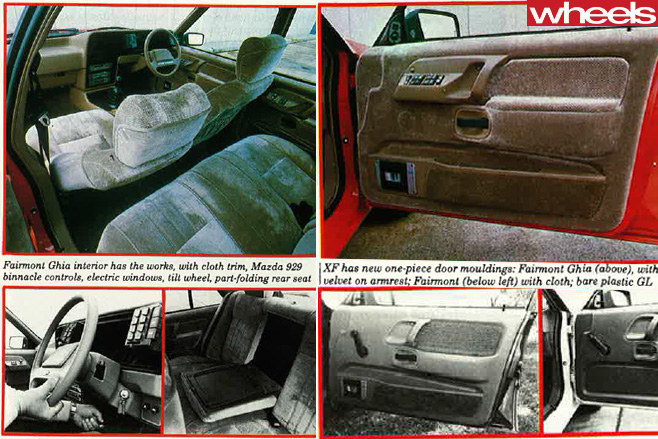
As with the standard and S Pack versions, a strip of warning lights runs across below the main cluster. With this layout the digital clock is at the centre of the panel in conjunction with a system-test/warning display.
A 12-function trip computer is standard in the LTD, optional for Fairlane and Ghia with the EFI engine.
If you think you’ve seen the high series models’ distinctive finger-tip switches before, you’ve seen the Mazda 929. Buttresses either side of the instrument binnacle accommodate batteries of push button and slide switches. Ford was so impressed with the 929’s system that it borrowed not only the concept and style, but even buys its assemblies from the same (Japanese) supplier. Identified by shape and illuminated symbols, the switches perform with almost hydraulic smoothness. Those in the right-hand bank control lights, antenna, backlight, demister and the standard-equipment cruise control. Those in the left-hand bank administer the high series models’ air conditioned climate control system.
The already good heater and ventilation systems have been extensively revised and improved on all models. The standard GL and Fairmont versions get four rotary switches across the centre panel to control air temperature, fan speed, air direction and such. Easily identified with illuminated symbols, the new controls are also easy to use and seem just about foolproof.
Fresh or recirculated air is available in all modes. Ford says that not only has fan noise been reduced but the total airflow is increased by about 12 percent. Whatever, it’s ample.
The excellent separate front footwell vents are retained, but Falcon’s traditional eyeball dash vents have been pensioned off in favour of louvre type outlets. There are two side by side at the centre, those in the Ghia, Fairlane and LTD having 929-like motorised vertical vanes so airflow continuously sweeps from side to side. There are also pairs of outlets at the panel ends, these stacked vertically. The upper one direct air to face level while the lower ones must be crotch coolers.
Air conditioned Fairmonts and higher models with floor-shift transmission also have air outlets at the rear of the centre console. Performance of the factory air is measurably improved with more effective evaporators and condensors to complement the ingenious new spiral type compressor which is lighter, quieter and more efficient than the previous piston type unit. The steering column
continues to carry two control stalks: turn/dip/horn on the right, and wash/wipe on the left. All models now have intermittent wipe position. Windscreen washing is improved with two twin-ball outlets, while the wagons now have a separate pump for the rear window washer.
Acknowledging the importance of ear appeal, ford has substantially upgraded the cars’ sound systems. All GL models have good quality AM/FM radio/cassette players as standard. The Fairmont, Ghia and Fairlane share an electronically tuned four-speaker system with auto reverse cassette player with Dolby noise reduction.
Standard in the LTD (optional for Fairlane and Ghia) is what Ford claims to be the best OE sound system yet in an Australian car. It consists of a modular triple decker console unit withAM/FM tuner, tape player and graphic equaliser plus separate amplifier. It has the same front speakers as the mid-models’ system but adds a pair of special rear speakers, each containing triaxial speakers (woofer, mid-range, tweeter) linked by an electronic network.
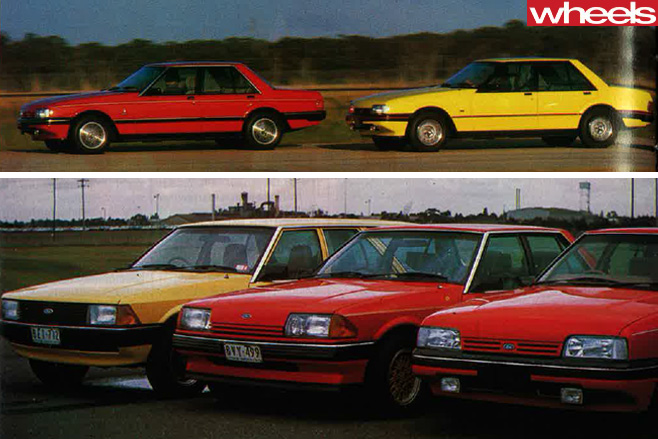
The lwb models gain some headroom however (10 mm front, 14 mm rear), thanks to a moulded headlining made of material similar to that in the Telstar: basically a type of corrugated cardboard. Other interior details include a centre console for GL models, with a different design using vinyl trim for the others except the LTD, which has its own velour trimmed version. Ghia and higher models have map pockets behind the front seats, while Fairmonts and higher also have front and rear door pockets. They also have a passenger vanity mirror which (except in the Fairmont) has a small covering flap.
As before, there are three six-cylinder engines in 3.3 litre and 4.1 litre capacities with carburettors, and 4.1 litres with injection. Being the top of the range, the 4.1 EFI engine is the feature of interest. The latest version claims 120 kW maximum power at 4000 rpm (up from the XE’s 111 kW at 3800 rpm), with 333 Nm maximum torque at 3000 rpm (versus 325 at 2800 in the XE). Even with the extra performance, the 4.1 EFI, like the carburettor 4.1 and 3.3, shows measurable gains in fuel consumption.
Much of the improvement in the 4.1 EFI engine is due to the adoption of a very advanced electronic control module known as EEC4 (Electronic Engine Control) which manages the spark timing as well as the air-fuel mix much more efficiently than the previous system.
Besides looking after the spark and fuel injection systems, EEC4 adjusts the idle speed according to engine temperature, whether the transmission is in Neutral or Drive, and whether the air conditioning is on or off. It’s also programmed to purge the evaporative emissions control canister at the most appropriate times during the emissions test cycles.
Various reliability and service features are included with EEC4, among them a limp-home ability. Should a malfunction occur the spark control and fuel flow valves revert to fixed values, enabling the car to be driven with reduced performance.
On a practical note, the EEC4 features simplified diagnostic procedures. Ford claims it takes only two minutes to trouble-shoot the system with hand-held instruments. It’s all pretty impressive stuff for a box about the size of a car radio.
Important as the EEC4 module is to the EFI engine, it can’t take all the credit for the improvements. It’s aided by changes to the throttle body, air flow meter, injectors and related areas. Other contributing factors include larger intake valves, revised piston rings to improve sealing while reducing friction, new camshaft, revised oil seals for reduced friction and a new High Energy ignition system. The changes extend to cooling system improvements with a different radiator for more efficient heat transfer, and a lightweight plastic fan with temperature sensitive viscous clutch. Both 4.1s get an improved starter motor.
The carburettor engines haven’t been forgotten. The 3.3 litre version, which went into more than 20 percent of XE Falcons (more than 18 percent of the cars and 37 percent of the commercials), doesn’t claim any change from the previous maxima – 90 kW at 4100 rpm and 240 Nm at 2500 rpm. But it’s said in fact to give better low through mid-range performance and consistently gives lower fuel consumption according to the AS 2077 test cycles.
That’s also true of the carburettor 4.1 engine which declares improved performance too. Maximum power is up to 103 kW at 3750 rpm, against previous 98 kW at 3800 rpm, with maximum torque lifted to 316 Nm at 2400 rpm from the XE’s 305 at 2300. The carburettor engines share a redesigned cylinder head, still a cross-flow aluminium alloy unit cast by Honda, but with a new combustion chamber.
Drawing from current fast/lean-burn technology, the chamber promotes swirl by partially masking the inlet valve, which has larger diameter than before to assure adequate gas flow. Like the EFI 4.1, the carburettor engines use long nose spark plugs, also share the low-friction piston rings and crankshaft seals. They have their own ignition systems and emissions controls. Interestingly, their compression ratios don’t align. The EFI model has least squeeze with 8.8 to one ratio while the carby 4.1 is highest with 9.35 to one and the 3.3 is 9.15 to one.
There’s variety in the fuel tanks too. Commercials have 68 litres capacity, the wagons 72 litres, and the GL/Fairmont sedans 66 litres standard, but with the 80 litre Ghia/Fairlane/LTD tank optional.

Changes to the suspension and steering aren’t headliners, but make their presence felt. Power steering is now standard on Fairmonts and everything above, optional for GL and base models. There’s also a new power steering pump, which is lighter, quieter and said to be more reliable with similar servicing schedule.
Further development of the front and rear suspension aimed to improve the ride and stability without detriment to the handling. To that end the dampers have been completely re-valved. Revised suspension bushes helped improve compliance (said to be particularly effective in the wagons’ rear suspension), while also contributing to reduced Noise, Vibration, Harshness.
NVH was an area which commanded serious attention in the new series. In the Fairlane and LTD, for instance, an internally tuned driveshaft assembly was introduced to cut transmission noise. Extensive laboratory testing revealed that the floor pan and dash panel were critically sensitive NVH sources. Substantial improvements resulted from insulating or isolating the affected areas with revised designs, different construction and/or more effective sound proofing.
Extra effort was devoted to the wagons’ NVH program. In addition to new (oval) rear spring bushes, the exhaust system was revised, a heavier flywheel fitted, and better sealing of the rear compartment achieved with improved carpeting and additional sound-proofing/damping.
While the new Falcons include many more features and much more equipment as standard there’s also a long and broad list of options. There are too many to outline here, except two which are bound to be the most popular packages. One is GL/Fairmont/Ghia sedan Sports Handling Suspension kit which includes lower, stiffer springs with Bilstein gas dampers and thicker front anti-roll bar. No firm price, but a usually reliable source mentioned . . . “less than $150.”
Then there’s the ever-popular S Pack, applicable to all GL models. This brings fog lamps, 12-slot steel wheels with trim rings, the sports instrumentation, black bodyside stripes, cloth seat covers, ER70H14 tyres, blacked-out door frames, adjustable steering column, driver’s cushion tilt, driver’s footrest, red Falcon and S decals on the tail and with black window frames and drip mouldings. Wheels influence a car’s appearance and also its performance: depending on spec, the GL comes with either 5.5 inch or six inch rims, in 14 inch diameter, the wider version shared with Fairmont and Fairlane.
These three have wheel covers; with 10 holes for the GL, eight for the Fairmont and turbine-like radial blades for the Fairlane. A 14×6 inch alloy 16 spoke design is optional for those models.
The Ghia has the carried-over Snowflake style alloy wheels in 15×7 size as standard, while the LTD’s standard alloy Moon Discs are 15×6.5 inches and have a large fiat face with 15 narrow slots.
***
HOW LONG ago 1960 seems. The brand new XK Falcon offered 2.4 litres engine capacity and 67 kW maximum power. It gave about 8.5 km/1 (25 mpg) overall, covered the standing quarter mile in the 21s, and could be wound up to about 140 km/h fiat out.
Today’s Ford Falcon is an altogether bigger and heavier car, of course. It’s infinitely more refined and complex, albeit still with six cylinders under the bonnet. But at top level it boasts 4.1 litres and 120 kW. Its consumption still averages around the mid 20s but it covers the standing 400m in the low 16s and has top speed knocking on 200 km/h.
To confirm that the XF is definitely a goer we ran a full set of acceleration figures (see accompanying table) on an S Packed GL sedan with four-speed 4.1 EFI engine. Averaged from runs in opposite directions with two people aboard, the figures prove the big Falcon doesn’t hang about. It covered the 400m in just 16.4 seconds, having reached 100 km/h in only 9.3 seconds.
Apart from being very quick through the gears, despite the lowly 4500 rpm redline, the engine feels really strong in the gears too, an impression borne out by excellent times through the mid-range increments in second and third. Fourth gear is very tall, a long-legged 2.77 to one, for easy and economical cruising with 42.5 km/h per 1000 rpm.
Even so, the XF has power enough to wind right to the red line in top gear, translating to an honest 190 km/h. At that the Falcon is much faster than its speedo.
We also had a four-speed 4.1 EFI Ghia and a carby 4.1 automatic at the track for the preview session. We didn’t check their performances against the clock, but seat-of-the-pants impressions corroborated the S car’s results.
Surprisingly, or perhaps not, the automatic version wasn’t far behind … about two seconds slower to 100 km/h and climbing to a top speed of 180 or so.
Working to tight deadlines for the new models’ release, Ford wasn’t able to field a preview Fairlane and LTD; didn’t have either one ready even for photography, let alone for driving.
We got a good insight into the others however, with drivetime at the You Yangs proving ground as well as on the road. It must be admitted that the Ghia with optional Sports Suspension was our favourite for its higher standard of handling and cornering, but that’s to take nothing from the GL with the S pack and the stock Fairmont. They also handle well, with obviously more body roll and floatiness when pushed really hard, but with a comfortable advantage in ride. The Sports Suspension firms up the ride, not to the point of harshness, but enough to feel the difference after the softer standard system.
The brakes haven’t received any noteworthy changes for the XF, and feel as good as we remember, powerful without being susceptible to lock-up, and with a modulated pedal.
Living up to the improved claim, the XF steering feels better than previous Falcons. That doesn’t include the turning circle, which remains disappointingly large – as it has been since 1960 – but the power assistance is nicely weighted and reasonably direct. The adjustable column is a boon to comfortable driving, especially with the tiltable seat cushion.
Being pre-production examples, the preview cars could be excused the stray squeak from behind the dash and a random rattle or two from the body on rough roads. We’ll also give them the benefit of the doubt on the moderate to intrusive wind noise from allegedly sub-standard door shut gaps.
Ford persons said the production cars’ better door fit will alleviate the windrush. We hope so. In other respects the new models seem quiet. There were no such teething problems with the new instruments and switch/control system. Even the base binnacle isn’t unattractive. The sports version is very good after a little familiarity, and the all-electronic alternative is one of the best in our experience.
It still takes some getting used to, but doesn’t attempt to be an all-singing, all-dancing juke box, and the displays don’t seem to suffer much debilitation in strong light, although that has yet to be confirmed at the height of summer.
The fingertip switches are a tangible advance over conventional controls, fully justifying their inclusion. Merit marks are also scored by the rotary vent/heat controls, and also by the sheer amount of ventilation available from them.
So it remains for time and full road tests to tell how the new Falcon really measures up. But for now the first-drive impressions leave us in little doubt that the XF is as improved on the road as it is on paper … a far cry from 1960 to what is, we suspect, by far the best Falcon ever.
Check out Wheels Archive online now for other great Ford Falcon features and more from decades past!
Simply log in here using your existing MagShop account or create a FREE account and select this article from the homepage.
Don’t have a MagShop account?

Have a MagShop account?


